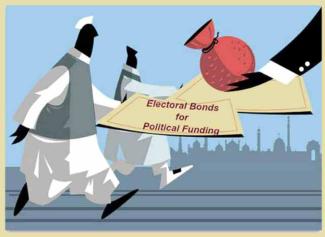Enabling BJP And Its Donors To Benefit From Black Money And Corruption
Investigative journalists of the Reporters’ Collective have recently uncovered the contents of the “sealed cover” submitted by the Election Commission of India to the Supreme Court in 2020 in a hearing of petitions challenging the legality of the Modi regime’s policy of Electoral Bonds.
In 2017, the BJP introduced Electoral Bonds, supposedly to ‘cleanse the political system’ of corrupt donations and bring ‘transparency’ to political funding. But do Electoral Bonds ensure transparency or its opposite?
What should transparency in political funding mean? It should mean that “we the people” have full knowledge of which persons and companies contributed how much to which party/parties. Why should political funding be public knowledge? So that “we the people” can judge whether or not the funding is resulting in corruption: i.e is the party (whether in Government or in Opposition) acting to benefit its big funders rather than the Indian public. So, if we know that Adani is donating large sums of money to the BJP, and then the BJP Government is making farm laws (or selling PSUs) to disproportionately benefit Adani, then we can conclude that the BJP is indulging in crony capitalism and corruption.
Electoral Bonds, instead of letting the Indian voting public know who is donating how much to which party, allows persons and companies (both Indian and foreign) to anonymously donate unlimited sums of money to political parties. In other words, Electoral Bonds prevent Indian citizens from knowing the identity of donors and details of donations – and thus it provides cover for corruption.
In 2017 itself, petitions were filed in the Supreme Court challenging Electoral Bonds, pointing out that they would enable rather than hinder political corruption. In March 2019, the Election Commission of India itself filed a writ petition asking the Supreme Court to roll back the Electoral Bonds scheme, warning that this scheme would enable the flow of black money into election funding and would even allow foreign entities to influence Indian politics and political decision-making. Surely such a warning by the Election Commission of India warranted top priority attention by the Supreme Court? But in April 2019 the SC asked the EC to submit details of political parties that had benefited of electoral bonds as well as details of funding amounts – in a sealed cover. Two whole years and a general election and several state elections later, the SC is yet to open the sealed cover, and has last held a hearing in the matter in January 2020. This speaks volumes for the concern and urgency our constitutional watchdog feels to prevent corruption, cronyism, black money, and foreign funding from vitiating Indian politics!
The EC had stated that 105 parties had replied to its 2019 query about funding through Electoral Bonds, including 7 national parties, 3 state units of national parties and 20 state parties and 75 unrecognised registered parties (with names like ‘Hum aur Aap Party’, ‘Asli Deshi Party’ and ‘Sabse Badi Party’). It was implied that Electoral Bonds funding was spread across these 105 parties. The Reporters’ Collective tracked down each of these parties to find out what they had submitted to the EC: the only way to find out the contents of the ‘sealed cover’.
Shreegireesh Jalihal of the Collective, stated in a tweet: “What we found: All of the unrecognised parties and nearly half of the state parties on the EC list had never received any funds from Electoral bonds. Soon, a pattern emerged: These parties were asked by the EC to send sealed cover letters even if they did not get any bonds.” Of the 105 parties named by the EC, only 17 had actually received funds via Electoral Bonds, and two other parties that had not submitted letters to the EC had also received funds. So clearly, the Electoral Bonds scheme was benefiting a far smaller number of parties than that implied by the Election Commission’s list.
How were the funds received through Electoral Bonds distributed across the beneficiary parties? Jalihal tweeted: “Over the three financial years we analysed, the BJP grabbed a whopping 67.8% of all funds through electoral bonds -- over Rs 4,215 crore of the Rs 6,201 crore sold in the period.”
Doesn’t the Electoral Bonds scheme prevent parties from knowing the identity of donors? Yes – but the significant exception is the ruling party at the Centre! Since the central Finance Ministry regulates the State Bank of India which is the only bank authorized to issue and encash the bonds, the Central Government and the ruling party can easily find out the identity of donors. This makes any decision by the ruling party or Government that benefits any of its donors, a potentially corrupt decision – all the more so because the scheme is designed to keep the donors’ identity hidden from voters and citizens.
Jalihal summarises the situation: “Secret donors are providing large sums of unaccounted money largely to the one political party which can potentially find out who the donations go to -- the party in power at the Centre, which regulates the SBI through the finance ministry. The farcical sealed cover of 105 parties with the Supreme Court holds nothing that could not have been found out by the court ordering the State Bank of India to tell any day. It has not heard the case for over 2 years and the money keeps rolling in for some.”
Why is the Supreme Court delaying the hearing of the challenges to this scheme? This delay is only allowing the ruling BJP to benefit from large, secret donations from donors – allowing it to make policies to benefit these donors instead of the people of India.











